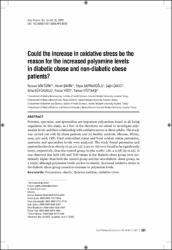Could the increase in oxidative stress be the reason for the increased polyamine levels in diabetic obese and non-diabetic obese patients?

Göster/
Erişim
info:eu-repo/semantics/openAccessTarih
2022Yazar
Göktürk, NurcanŞahin, Hicret
Bayramoğlu, Feyza
Çakıcı, Çağrı
Büyükuslu, Nihal
Yiğit, Pakize
Yiğitbaşı, Türkan
Üst veri
Tüm öğe kaydını gösterKünye
Göktürk, N., Şahin, H., Bayramoğlu, F., Çakıcı, Ç., Büyükuslu, N., Yiğit, P. ... Yiğitbaşı, T. (2022). Could the increase in oxidative stress be the reason for the increased polyamine levels in diabetic obese and non-diabetic obese patients? Acta Pharmaceutica Sciencia, 60(3), 301-312. https://doi.org/10.23893/1307-2080.APS.6020Özet
Putresin, spermine, and spermidine are important polyamines found in all living organisms. In this study, as a first in the literature, we aimed to investigate polyamines levels and their relationship with oxidative stress in obese adults. The study was carried out with 85 obese patients and 29 healthy controls. Glucose, HbA1c, urea, uric acid, CRP, Total antioxidant status and Total oxidant status putrescine, spermine and spermidine levels were analysed. The study found putrescine and spermidine levels in obesity (0.25 ±0.13) (2.29 ±0.79) were found to be significantly lower, respectively, than the control group (0.38± 0.08) (1.80 ± 0.68) (p<0.05). It was observed that both OSI and TOS values in the diabetic obese group were statistically higher than both the control group and the non-diabetic obese group. As a result; although polyamine levels are low in obesity, increased oxidative stress in the diabetic obese group caused an increase in polyamine levels.
Scopus Q Kategorisi
Q3Kaynak
Acta Pharmaceutica ScienciaCilt
60Sayı
3Koleksiyonlar
- Diğer Yayınlar Koleksiyonu [257]
- Makale Koleksiyonu [79]
- Makale Koleksiyonu [3751]
- Scopus İndeksli Yayınlar Koleksiyonu [6522]

















